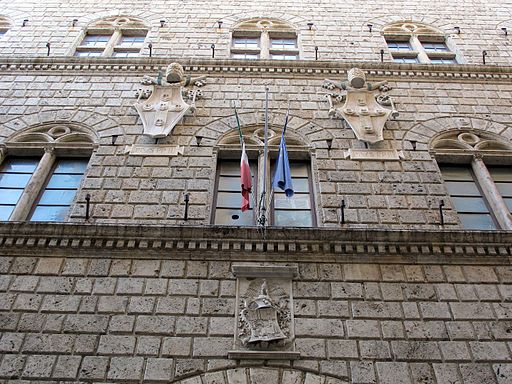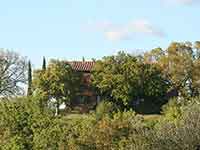Dietisalvi di Speme |
Dietisalvi di Speme was an Italian painter, who worked in Siena between 1250 to 1291. His work influenced Cimabue. Some of his work is preserved in the State Archives in Siena. His Madonna and Child with Angels is in the Pinacoteca di Siena. He collaborated with Guido da Siena.
|
| His name, meaning May-God-Save-You (son) of Hope seems likely to be of the kind often given to a child abandoned by its mother and raised as an orphan. The first mention of him is dated 1250 and was found in the records of the Biccherna or financial administration of Siena, a mention now lost but transcribed in the eighteenth century by Giovan Girolamo Carli. This administration had the custom of having the covers of its accounting books decorated. In this contest there are mentions of Dietisalvi di Speme in 1261, 1262, 1276, 1278, 1282-1283 and 1284. Overall he seems to have painted some 56 such covers between 1259 and 1288. Of all these, only four have survived, and these are in fact his only documented works. The authorities seem to have employed only Dietisalvi in the years 1259-1272 and after this they instituted a system of calling also upon other painters (including Duccio), though Dietisalvi seems to have received the lion’s share of the commissions. |
||
 |
||
Dietisalvi di Speme, Madonna Galli-Dunn, 1265 circa, tempera e oro su tavola, 120×70 cm, Pinacoteca nazionale, Siena
|
||
| The type of Maestà derives from the Madonna del Bordone by Coppo di Marcovaldo, but inspired by the Byzantine type of Odigitria, the Madonna, symbolizing the Church, which indicates the way of salvation, that is Jesus. Compared to the work of Coppo (dated 1261), here there are other innovations, such as the greater lateral deviation of Maria's legs and the clothing of the Child, which has stopped the role of the little philosopher to wear a less formal tunic, kept alive by a knotted lace. The decorative aspect is sumptuous and striking: the dazzling blue, red and white are enriched in draperies with golden aground, and the halos of Jesus and Mary are embellished with oval settings, now in copper, now in silver, with rock crystals which, in the case of Mary, ideally continue in the round neck brooch, of the same material. Even in the general inspiration, the folds show a certain rigidity, to want to bring the fabric back into geometric patterns, which simplify and rhythmically elegant the randomness of the relapses. To increase the brightness, the draperies were also retouched with lacquers and the lapel of Maria's sleeve was painted over the gold, of a bright green today oxidized. The same technique is used in the throne, for example in the imperial eagles painted in the medallions of the throne. Jesus blesses the Greek, with the little finger raised, and crosses his legs, just like those in the Majesty of San Domenico by Guido da Siena, which obviously derives from this one (and not vice versa as was long believed). The thick locks of his hair refer directly to Coppo. The crowning of the table is equipped with a trilobate arch, beyond which two small angels appear. The cuspidate table is then closed by an original corncie, with golden decorations and small flowers in relief (in tablet) on a blue background. |
 Dietisalvi di Speme, Madonna Galli-Dunn, 1265 circa, tempera e oro su tavola, 120×70 cm, Pinacoteca nazionale, Siena Dietisalvi di Speme, Madonna Galli-Dunn, 1265 circa, tempera e oro su tavola, 120×70 cm, Pinacoteca nazionale, Siena |
|
Cripta del Duomo di Siena
|
||||
| Painted by artists working in Siena in the second half of the 13th century – men such as Guido da Siena, Dietisalvi di Speme, Guido di Graziano and Rinaldo da Siena – the cycle of paintings is remarkable for the brightness of the colours covering not only the frescoed walls but also the columns, pilasters, capitals and corbels with geometric or phytomorphic embellishments. The scenes are arranged on two registers with stories from the Old Testament in the upper register and stories from the New Testament in the lower register. The mesmerisingly solemn depiction of the Passion of Christ captures the three great moments of the Crucifixion, the Descent of Christ from the Cross and the Entombment.[2]
|
 The Crypt or undercroft beneath Siena Cathedra The Crypt or undercroft beneath Siena Cathedra
|
|||
 |
 |
 |
||
Scuola senese, affrescchi, 1280 circa
|
Scuola senese, Annunciazione, 1280 circa | Cripta del Duomo di Siena, Annunciazione e Visitazione, 1280 circa
|
||
 |
 |
 |
||
Deposizione dalla croce, 1280 circa, affresco, Siena, cripta del Duomo
|
Scuola senese, Crocifissione, 1280 circa
|
Cripta del duomo di siena, Sepoltura | ||
Crypt - Sites - Siena Opera della Metropolitana - Opera Duomo – Siena | www.operaduomo.siena.it Traveling in Tuscany |The Siena Duomo
[2] Source: OPA | IN THE BOWELS OF THE CATHEDRAL "CRYPT"i - Siena Opera della Metropolitana | The dawn of Sienese painting
|
||||
Podere Santa Pia. The typical amber light of sunset that colors everything with an incredible warmth
|
||||
|
Holiday accomodation in Tuscany | Podere Santa Pia | Artist and writer's residency
|
||||
Podere Santa Pia |
Podere Santa Pia, garden view, December |
Florence, Duomo |
||
 |
 |
 |
||
Palazzo Piccolomini, Siena, stemmi Piccolomini (Banchi di Sotto, Siena
|
Palazzo Piccolomini, Siena, courtyard
|
Vista meravigliosa dall Archivio di Stato sulla Torre del Mangia e su parte della piazza del Campo | ||
 |
||||
Monte Oliveto Maggiore abbey |
Abbey of Sant 'Antimo |
Libreria Piccolomini, affrescata da Pinturicchio
|
||
Questo articolo è basato sull' articolo Dietisalvi di Speme dell' enciclopedia Wikipedia ed è rilasciato sotto i termini della GNU Free Documentation License.
|
||||







